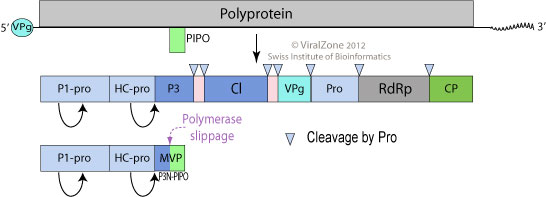Ipomovirus Genome on:
[Wikipedia]
[Google]
[Amazon]
''Ipomovirus'' is a genus of
 The genome is either monpartite or bipartite depending on the species. Member viruses have linear, single stranded RNA genome of positive polarity about 10-11 kilobases in length. The 3’ terminus has a poly (A) tract and the 5’ terminus has a genome linked protein (VPg).
Member viruses encode a single polypeptide with a predicted molecular weight of 390 kilo Daltons (kDa) which is cleaved into ~10
The genome is either monpartite or bipartite depending on the species. Member viruses have linear, single stranded RNA genome of positive polarity about 10-11 kilobases in length. The 3’ terminus has a poly (A) tract and the 5’ terminus has a genome linked protein (VPg).
Member viruses encode a single polypeptide with a predicted molecular weight of 390 kilo Daltons (kDa) which is cleaved into ~10
Viralzone: Ipomovirus
ICTV
{{Taxonbar, from=Q6065310 Virus genera Ipomoviruses
positive-strand RNA viruses
Positive-strand RNA viruses (+ssRNA viruses) are a group of related viruses that have positive-sense, single-stranded genomes made of ribonucleic acid. The positive-sense genome can act as messenger RNA (mRNA) and can be directly translated in ...
in the family '' Potyviridae''. Member viruses infect plants and are transmitted by whiteflies ('' Bemisia tabaci''). The name of the genus is derived from '' Ipomoea'' – the generic name of sweet potato
The sweet potato or sweetpotato (''Ipomoea batatas'') is a dicotyledonous plant that belongs to the Convolvulus, bindweed or morning glory family (biology), family, Convolvulaceae. Its large, starchy, sweet-tasting tuberous roots are used as a r ...
. There are seven species in this genus.
Structure
Viruses in genus ''Ipomovirus'' are non-enveloped, with flexuous and filamentous geometries. The diameter is around 12–15 nm, and may have a variety of lengths depending on the species (for single segmented species lengths of around 650–900 nm, or for double segmented species 200–300 nm and 500–600 nm). The capsid has helical symmetry with a pitch of 3.4 nm. They induce characteristicinclusion bodies
Inclusion bodies are aggregates of specific types of protein found in neurons, a number of tissue cells including red blood cells, bacteria, viruses, and plants. Inclusion bodies of aggregations of multiple proteins are also found in muscle cells ...
(pinwheels) within infected plant cells.
Genome
 The genome is either monpartite or bipartite depending on the species. Member viruses have linear, single stranded RNA genome of positive polarity about 10-11 kilobases in length. The 3’ terminus has a poly (A) tract and the 5’ terminus has a genome linked protein (VPg).
Member viruses encode a single polypeptide with a predicted molecular weight of 390 kilo Daltons (kDa) which is cleaved into ~10
The genome is either monpartite or bipartite depending on the species. Member viruses have linear, single stranded RNA genome of positive polarity about 10-11 kilobases in length. The 3’ terminus has a poly (A) tract and the 5’ terminus has a genome linked protein (VPg).
Member viruses encode a single polypeptide with a predicted molecular weight of 390 kilo Daltons (kDa) which is cleaved into ~10 protein
Proteins are large biomolecules and macromolecules that comprise one or more long chains of amino acid residues. Proteins perform a vast array of functions within organisms, including catalysing metabolic reactions, DNA replication, respo ...
s. In 5'–3' order these proteins are
*P1 (a serine
Serine (symbol Ser or S) is an α-amino acid that is used in the biosynthesis of proteins. It contains an α-amino group (which is in the protonated − form under biological conditions), a carboxyl group (which is in the deprotonated − form un ...
protease
A protease (also called a peptidase, proteinase, or proteolytic enzyme) is an enzyme that catalyzes (increases reaction rate or "speeds up") proteolysis, breaking down proteins into smaller polypeptides or single amino acids, and spurring the ...
): 83 kDa
*HC (a protease): 51 kDa
*P3: 34 kDa
*6K1: 5 kDa
*Cl ( helicase): 71 kDa
*6K2: 6 kDa
*VPg (the 5' binding protein): 20 kDa
*NIa-Pro (a protease): 27 kDa
*NIb (RNA dependent RNA polymerase
RNA-dependent RNA polymerase (RdRp) or RNA replicase is an enzyme that catalyzes the replication of RNA from an RNA template. Specifically, it catalyzes synthesis of the RNA strand complementary to a given RNA template. This is in contrast to ...
): 57 kDa
*Capsid protein: 34 kDa
There may be some variation in the number of the proteins depending on the species, for instance some ipomoviruses lack HC and have a P1 tandem. Inosine triphosphate pyrophosphatase
Inosine triphosphate pyrophosphatase is an enzyme that in humans is encoded by the ''ITPA'' gene, by the ''rdgB'' gene in bacteria ''E.coli'' and the ''HAM1'' gene in yeast ''S. cerevisiae''; the protein is also encoded by some RNA viruses of the ...
(known as ITPase or HAM1) is an atypical protein domain identified in some ipomoviruses.
Life cycle
Viral replication is cytoplasmic. Entry into the host cell is achieved by penetration into the host cell. Replication follows the positive stranded RNA virus replication model. Positive stranded RNA virus transcription is the method of transcription. The virus exits the host cell by tubule-guided viral movement. Plants serve as the natural host. The virus is transmitted via a vector (white fly). Transmission routes are vector and mechanical.Taxonomy
The genus contains the following species: *'' Cassava brown streak virus'' *'' Coccinia mottle virus'' *'' Cucumber vein yellowing virus'' *''Squash vein yellowing virus
Squash may refer to:
Sports
* Squash (sport), the high-speed racquet sport also known as squash racquets
* Squash (professional wrestling), an extremely one-sided match in professional wrestling
* Squash tennis, a game similar to squash but pla ...
''
*'' Sweet potato mild mottle virus''
*'' Tomato mild mottle virus''
*'' Ugandan cassava brown streak virus''
References
External links
Viralzone: Ipomovirus
ICTV
{{Taxonbar, from=Q6065310 Virus genera Ipomoviruses